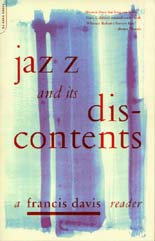Jazz And Its Discontents: A Francis Davis Reader
By Francis Davis
DaCapo
2004, $20, pp336
Jazz And Its Discontents: A Francis Davis Reader is the title of
the new collection of articles and reviews written by Francis Davis,
one of the most appreciated and respected music critics in today's US
media panorama. The volume presents writings that for the most part
had already appeared in his previous collections, titled In The Moment (1986), Outcats (1990) and Bebop And Nothingness
(1996), all now out of print. There are also some writings that appear
here in book form for the first time: the vintage writings grouped under
Bonus Tracks, the most interesting of which,
at least for this writer, being a Jim Hall profile from July 1983; and
some pretty recent articles which appear at the end of the book and
which are included in the section called Mixed Media, whose topics -
according to the author they form "a sort of war trilogy"
- should be of interest even to those readers who don't know much about
(or are not especially thrilled by) Bob Hope and the movie titled The
Best Years Of Our Lives. There's nothing here off Like Young (2001),
the most recent Francis Davis collection, nor from The History Of The
Blues and Afterglow: A Last Conversation With Pauline Kael, all of which
are still in print.
Just as is the case for every "Best Of" that's worth its
title, Jazz And Its Discontents could well provoke debates and heated
discussions about what has been included and what's been left out. But
the choice was Davis's, and I think that the book offers a view as complete
as it's possible.
All taken from In The Moment, the first four pieces that appear in
the book - An Improviser Prepares, on Sonny Rollins; No Success Like
Failure: Ornette Coleman's Permanent Revolution; Leading Lady, on Abbey
Lincoln; and Anthony Davis's New Music - give a very good idea of the
width and depth of the territory covered by the book and are also a
good example of the way the author sees the goal of the music critic:
part profile, part interview, with enough depth to them as to interest
those already in the know, they can well function as an introduction
for those who read about these matters for the first time. Davis knows
how to make things wider without making things difficult for the reader,
who never feels unable to follow the thread. It's well worth noting
how well "general themes" are woven inside the narrative -
for instance, check the intro to Black Like Him, the piece on Bobby
Short.
If I had to make a list of the pieces in this volume that I consider
as the most interesting (but almost anybody will be able to find topics
to his/her taste) I'd say the aforementioned profiles of Rollins, Coleman
and Davis; the Ellington portrait - and the writing titled Ellington's
Decade, which analyzes the relationship between Ellington and the modern
avant-garde; the piece on Herbie Nichols; the articles on Ran Blake
and Borah Bergman; the profile of Susanna McCorkle; all off Outcats.
Also impossible to miss are the pieces on Lester Young, Art Blakey,
John Zorn, Don Byron, Charles Gayle and Roswell Rudd taken from Bebop And Nothingness. Also well worth a read are
the section titled Recurring Characters, which offers multiple portraits
of Miles Davis, Sun Ra and Wynton Marsalis; the piece on rap, titled
Black Faces, Black Masks; and, from the section titled Mixed Media,
the text called At The Movies, which presents critical writings on the
movies 'Round Midnight, Bird and Let's Get Lost.
It's
obvious that the ideal reader for this volume will be in the first place
the jazz aficionado. Here, things are not so brilliant. On page xiii
of his book introduction, called Only Myself To Blame, Davis writes:
"Twenty-five years ago, when I started writing about jazz, it was
in decent shape artistically; the problem was its lack of exposure.
But Gary Giddins was writing about David Murray and Bireli Lagrene for
Vanity Fair, Ornette Coleman or Sun Ra might be the musical guest on
Saturday Night Live, and it was at least possible to sell a magazine
such as Esquire on the idea of a piece on Sonny Rollins. None of this would be
likely today. I hear people complain that the audience for jazz is getting
older, but isn't the audience for anything interesting and a little
out of the way, including art and repertory film?".
This
is quite obviously the crucial aspect of the problem. I know quite a
few people who believe the opposite to be true - that is, that adults
live perpetually at home wearing slippers, absolutely indifferent to
any stimulus that's just a tiny bit out of the ordinary, while young
people are those who are keeping any form of art&culture that's
"cutting edge" alive. Still, it's apparent that when things
like language are taken into consideration - the language that one has
to use to describe - and "build" - cultural artifacts - the
dividing line is a cultural one, starting with literacy. The present
dynamics - which are obviously "trends", but that it doesn't
seem likely will be reversed in the short term - seem to leave us with
not so much hope, in a situation where "sensations" remain
on the same plane of a shiver, never able to ascend to the plane of
the (dis)proof - i.e., of the verbal.
In
his introduction, Francis Davis already talks about his next collection,
to appear in a few years. Let's knock on wood.
Beppe
Colli
©
Beppe Colli 2004
CloudsandClocks.net
| April 23, 2004











